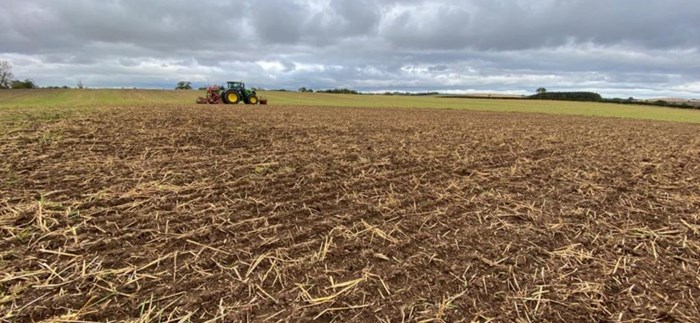- 19 October 2020

Winter crops drilled into mostly very good ground
With the winter drilling season pretty much over, in this blog Agrochemical & Technical Director David Cairns provides an overview as to how that has gone overall in our main trading areas of North Northumberland and the Scottish Borders.
Without wanting to jinx things, in general we’re in a much better position with autumn crop establishment than where we’ve been for a number of years in our main trading areas.
The ground going into the drilling period this year was in a lot better condition. Last year, the ground below surface level was very wet but this year, we were starting off on a much better platform so the ground could take a bit of rain. In fact, at one stage during the drilling period we were actually looking for rain because it was getting too dry.
Although we’ve had some rainfall events, on the whole there’s been considerably less rainfall than last year within our main trading areas. However, in other parts of the country, I’m aware that drilling is slightly better than last year but they’re still not making the progress that they’d like to because of the poor ground conditions as there has been some more significant rainfall.
Oil Seed Rape
Oil seed rape was drilled very successfully this year. We had crops drilled earlier than normal due to the keenness of the farmers to get them into the ground.
They’ve established really well with minimal slug damage and very little, if any, flea beetle damage. If I had put a criticism on them, in some cases I think some are too far forward!
But disease levels remain low, weed control programmes have generally been good and we’re now moving into the period where we need to assess whether we need to do any light leaf spot disease control and any follow-up Kerb herbicides but soil temperatures are just a bit warm at the minute.
Winter Wheat
A lot of wheat was drilled very early this year because a lot of farmers had the conditions of last year in the back of their minds. My earliest was drilled on August 23 and I think we’re at the stage now in this area where 95%+ drilled and there’s just the odd field of potatoes or grass where it’s still to go in.
A lot of farmers had their fields drilled by September 30 and again, like the rape, it was drilled into very good seed beds with minimal slug pressure, weed control programmes, while a lot of pre-ems are also done.
The big thing we’re watching out for at the moment is that there’s still quite a lot of aphid pressure and obviously with no seed dressings available, we’re having to monitor aphids and potentially put insecticides on – but we’ll risk assess that because we don’t want to put insecticides on if we can avoid it. But we’ve got aphids and barley yellow dwarf virus (BYDV) in our minds at all times.
Winter Barley
Much similar to wheat, all of the winter barley in this area is now drilled – again into very good ground and good plant stands. Unlike last year, the barley is getting the chance to get its roots down and isn’t sitting with cold wet feet, so early signs are good. Just like wheat, weed control programmes have generally been done well and we’re monitoring aphids quite carefully.
Winter Oats
Following up everything else that we’ve said, winter oats have also been drilled ahead of schedule and into good seed beds. So, on the whole, we’re very happy with autumn drilling. Everybody who wanted to sow winter crops has been able to do so and they’re all in good order, with a lot of good crop potential there.
Moving forward into the winter, we need rainfall – there’s no doubt about that – and we need, ideally, for temperatures to drop to stop pests. Then, we need the soils to warm up in the spring to get these crops away.
The problems that we’ve had in the past few seasons, though, are that we’ve not had steady rainfall over the course of two or three days – we have a massive rainfall event within, say, a 24-hour period, and that’s where the problems occur.
But because seed beds are so good this year and we had the dry summer that we did, the soil conditions are a lot better and that means the drainage in fields is better.
So at this time, growers should be working with agronomists to ensure that they’re looking at their nutrient management plans and making sure that they’ve got the right fertiliser for their crops heading into the winter months and into 2021.
Looking for some expert advice to tackle your farming challenges? Get in touch with us today to discuss how our dedicated team can help.

